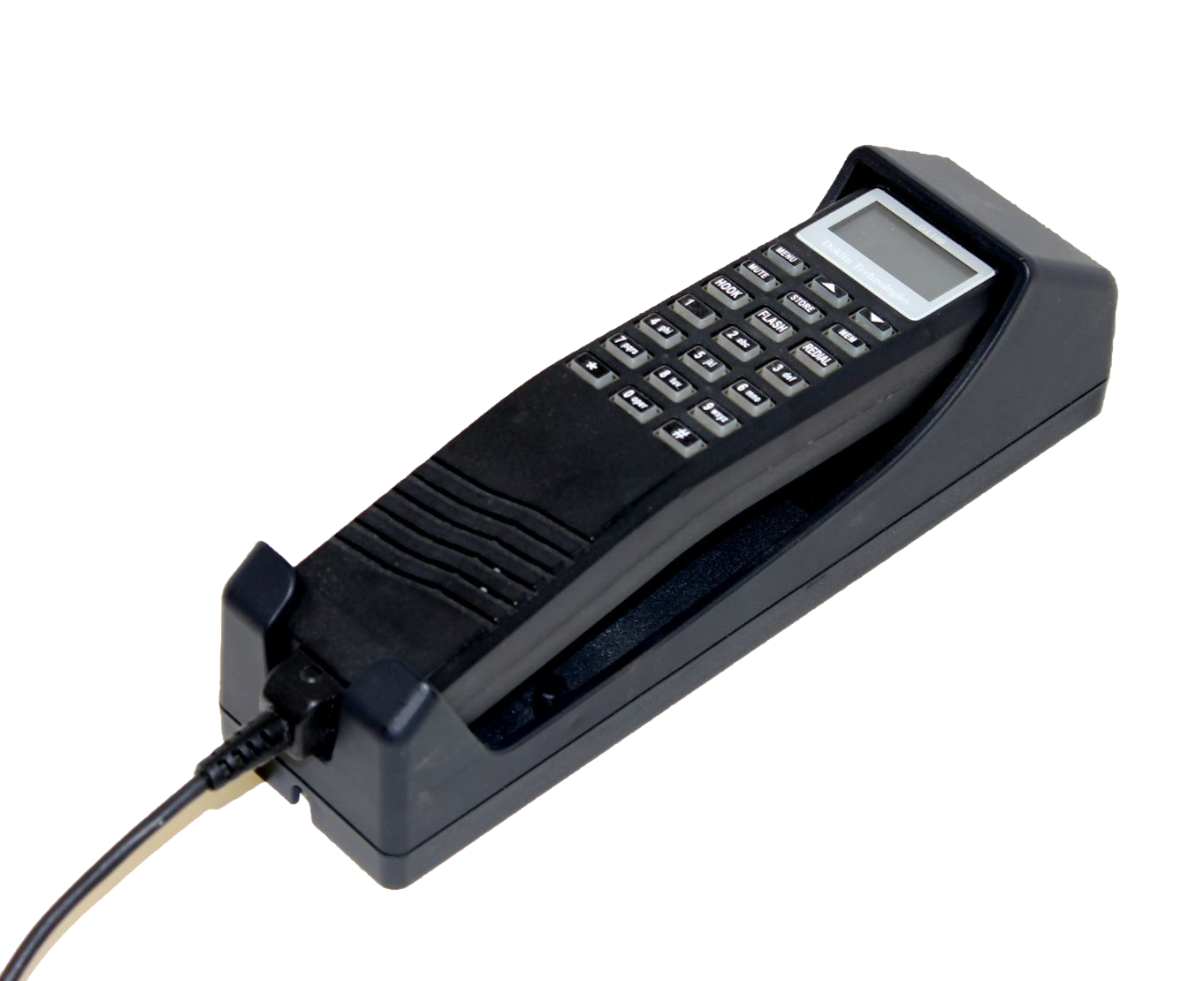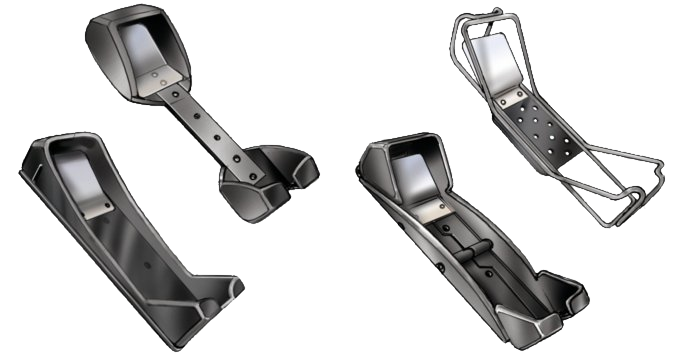
Deklin Technology, a company that offers products in aircraft communication, came to us to help design an aviation phone base for manufacturability and that met strict aviation standards.
“I am grateful for Creative Engineering. Because of their help, we are able to work with a client we have been trying to work with for over two years. And the new, sturdier product they created for us is opening doors into new markets.”
-Tracy Dendekker, President of Deklin Technologies
Product Website: http://www.deklintech.com/handsets.html
Company: Deklin Technology, North Aurora, Illinois
Product: Telephone Handset Base
Product Type: Electronics Housing
Target Markets: Original equipment manufacturers with clients in the aviation, marine and locomotive industries
Creative Engineering’s Challenge:
Create a secure, wall-mounted telephone base that can withstand the demands of flying.
Requirements:
Fit existing telephone handset securely
Utilize mounting points in the wall where the competitor’s handset is mounted, using two screws
Pass rigorous aviation electronics testing, including FAR25.853 flammability tests, and DO160 shock, vibration, and crash safety tests
Design parts so they can be manufactured using Protomold requirements
Sleek appearance, using hidden screws to keep the individual components in place
Creative Engineering Reaches New Heights with Aircraft Telephone Base Design
For those who’ve ever bought a home telephone, you know you can get a great quality phone for just about $25 and an outstanding quality phone for not too much more than $50. That’s not the case for the telephones used in commercial airplanes. You can bet the airline shelled out thousands of dollars for the phone you see used by flight attendants to call the captain. And there’s a good reason for the big price tag. Unlike home phones, phone systems used in aircraft must be designed and produced to withstand the unusual demands of flight. They must be extremely sturdy to endure turbulence and air pockets and work in any potential disasters such as fires and crashes. As manufacturer Deklin Technologies knows, more engineering than meets the eye goes into designing an aircraft-viable phone.
A supplier of aircraft telephones and accessories to original equipment manufacturers (OEMs), Deklin Technologies has found a way to produce these phones for far less than their competitors. With direct-from-manufacturer parts and little overhead, Deklin goes to market as the low-price leader, saving their OEM clients 50 percent or more on each system. Deklin also goes to market as one of the most customer-oriented companies around. When one potential client told Deklin they preferred their phone system over others but wished it had a few modifications, Deklin President Tracy Dendekker got to work looking for the right engineering firm to make them.
“The client wanted the phone to have a different base. I started by contacting some of the big engineering firms. I would leave messages and wouldn’t hear back for two to three weeks,” Dendekker says. “I found Creative Engineering through an Internet search. I talked to them and received a complete proposal in just a couple of days, with detailed costs.”
The project entailed redesigning the base of Deklin’s existing handset telephone for a commercial airline that was using a competitor’s model. The airline wanted a system that allowed their flight attendants to reach back and hang up the phone without getting out of their seats. Since Deklin’s existing phone model used two metal clips to snap the handset to the base, that wasn’t possible. They needed a more secure base that worked more like a cup holder. The client also wanted the new base to fit precisely where the current one did, mounted to the wall in the same place, with just two screws.
Creative Engineering Senior Design Engineer Norm Barrigas began by designing a new handset base that could meet the client’s requirements of being sturdier, more secure and easier to hang up than the original. He created conceptual sketches and then worked with industrial designer Bob Marvin to make the base smooth and appealing, so it would look good when the telephone handset was on or off the base.
Within one week, Creative Engineering presented Dendekker with a few different designs, walking through each of the 3D models (CAD) while discussing the design, material options, and pricing.
“Tracy originally wanted the base designed in metal, so it would be as sturdy as possible, but it was cost-prohibitive,” says Barrigas. “I suggested flame retardant polycarbonate, which worked well.”
Once Dendekker chose a design direction, Barrigas revised it to accommodate injection molded parts to save on manufacturing costs. They received the first round of parts within a week, which Barrigas determined weren’t rigid enough. He tweaked the design, making the wall thicker and redesigning the sheet metal piece so the base screwed in from the back, as Dendekker requested.
Creative Engineering handled every aspect of the project – from design to working with Deklin’s client to managing the manufacturing process.
“I trusted Norm to talk directly with my client. I knew he was representing me and my company professionally,” says Dendekker. “He made it easier on me by working with the client. But he didn’t stop there – he also found the manufacturers and got quotes for me. I didn’t have to get involved at all.”
The entire project took approximately two months to complete, from the proposal stage to the finished product.
DT100 Handset Base Components
The handset and base combined are 0.6 pounds, and can:
Operate in up to 105 degrees Fahrenheit
Survive temperatures up to 158 degrees Fahrenheit
Perform at an altitude of up to 35,000 feet
The handset is made up of four parts held together by eight screws:
Upper housing and lower housing made of flame-retardant polycarbonate
Spring made from 304 series stainless steel to provide force that holds the handset rigidly in place
Strain relief made of aluminum to provide extra protection to cables and wiring harnesses, extending cord life and reinforcing the cord connection to the equipment
The DT100 Telephone Handset with Locking Cradle passed flammability and environmental testing and has been delivered to the client. Deklin is in talks with several other OEM clients interested in selling the phone system to be used in other airplanes, as well as in yachts and trains. To get more information about Deklin products, go to http://www.deklintech.com.
Comments From our Client
Tracy says she was so happy with the finished handset base and the process of working with Creative Engineering, she has chosen to work with us on designing a retractable cord. She tells prospective clients they can expect the following if they choose Creative Engineering:
Dependability, Reliability, Professionalism: “When Norm told me I’d have something by the end of the week, I’d have it by Thursday. He lived up to his word. Creative Engineering did everything they said they would do, and they did it well.”
Communication: “They were responsive from the beginning, providing a proposal in a couple of days when others didn’t respond for weeks. And they kept me updated throughout the project.”
A firm that cares about your budget: “They were very conscious of my budget, giving me options for reducing costs.”
See some of our other military projects:








